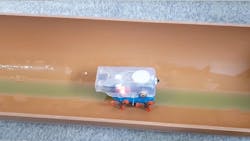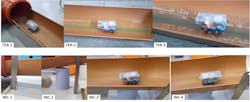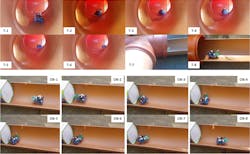Prototype robot can independently inspect narrow pipes
Researchers from the University of Leeds have developed a miniature robot that can move independently through narrow pipes to inspect for damage or leaks.
According to Frontiers Science News, the robot, named Joey, is cheap to product, smart, small, and light. The Joeys can also move through pipes inclined at a slope or over slippery or muddy sediment at the bottom of the pipes.
Regular inspection of pipes for leaks or damages normally requires these to be dug up. This process is not only onerous and expensive but can cause disruption to traffic and the environment. Autonomous inspection/repair robotics present an opportunity for immense savings for drinking water and wastewater distribution systems.
The researchers’ findings were published in Frontiers in Robotics and AI.
The team says that Joey is the first to be able to navigate all by itself through mazes of pipes as narrow as 7.5 cm across. Weighing just 70 g, it’s small enough to fit in the palm of a hand.
Pipebots Project
The present work forms part of the ‘Pipebots’ project of the universities of Sheffield, Bristol, Birmingham, and Leeds, in collaboration with United Kingdom utility companies and other international academic and industrial partners.
Joey moves on 3D-printed ‘wheel-legs’ that roll through straight sections and walk over small obstacles. It is equipped with a range of energy-efficient sensors that measure its distance to walls, junctions, and corners, navigational tools, a microphone, and a camera with spotlights to film faults in the pipe network and save the images. The prototype cost only £300 ($356 USD) to produce.
Mud and Slippery Slopes
The team showed that Joey is able to find its way, without any instructions from human operators, through an experimental network of pipes including a T-junction, a left and right corner, a dead-end, an obstacle, and three straight sections. On average, Joey managed to explore about one meter of pipe network in just over 45 seconds.
Currently, Joeys have one weakness: they can’t right themselves if they inadvertently turn on their back, like an upside-down tortoise. The authors suggest that the next prototype will be able to overcome this challenge. Future generations of Joey should also be waterproof, to operate underwater in pipes entirely filled with liquid.
Joey’s Future
The Pipebots scientists aim to develop a swarm of Joeys that communicate and work together, based off a larger ‘mother’ robot named Kanga. Kanga, currently under development and testing by some of the same authors at Leeds School of Computing, will be equipped with more sophisticated sensors and repair tools such as robot arms, and carry multiple Joeys.
“Ultimately we hope to design a system that can inspect and map the condition of extensive pipe networks, monitor the pipes over time, and even execute some maintenance and repair tasks,” says Cohen. “We envision the technology to scale up and diversify, creating an ecology of multi-species of robots that collaborate underground. In this scenario, groups of Joeys would be deployed by larger robots that have more power and capabilities but are restricted to the larger pipes.”



